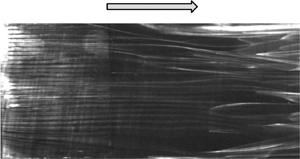Crossref Citations
This article has been cited by the following publications. This list is generated based on data provided by
Crossref.
Yu, Jianing
Fan, Dewei
Noack, Bernd. R.
and
Zhou, Yu
2021.
Genetic-algorithm-based artificial intelligence control of a turbulent boundary layer.
Acta Mechanica Sinica,
Vol. 37,
Issue. 12,
p.
1739.
Wong, Chi Wai
Cheng, Xiaoqi
Fan, Dewei
Li, Wenfeng
and
Zhou, Yu
2021.
Friction drag reduction based on a proportional-derivative control scheme.
Physics of Fluids,
Vol. 33,
Issue. 7,
ZHENG, Borui
JIN, Yuanzhong
YU, Minghao
LI, Yueqiang
WU, Bin
and
CHEN, Quanlong
2022.
Turbulent drag reduction by spanwise slot blowing pulsed plasma actuation.
Plasma Science and Technology,
Vol. 24,
Issue. 11,
p.
114003.
Feng, Yan-yan
Zheng, Zhanying
Liu, Hua-ping
and
Zhou, Yu
2022.
Effect of exit geometry of blowing air on friction drag of an underwater plate.
Ocean Engineering,
Vol. 257,
Issue. ,
p.
111719.
Zong, H.
Su, Z.
Liang, H.
and
Wu, Y.
2022.
Experimental investigation and reduced-order modeling of plasma jets in a turbulent boundary layer for skin-friction drag reduction.
Physics of Fluids,
Vol. 34,
Issue. 8,
Asadi, Masoud
Kamruzzaman, Md.
and
Hearst, R. Jason
2022.
Structure of turbulent channel flow subjected to simultaneous inlet turbulence and localized injection.
Physical Review Fluids,
Vol. 7,
Issue. 12,
Chen, Dengke
Chen, Huawei
and
Cui, Xianxian
2022.
Dual-coupling drag reduction inspired by tuna skin: Fan-shaped imbricated fish scale composited with flexible coating.
AIP Advances,
Vol. 12,
Issue. 3,
Zhang, X.
Wong, C. W.
Cheng, X. Q.
and
Zhou, Y.
2022.
Dependence of skin-friction reduction on the geometric parameters of blowing jet array.
Physics of Fluids,
Vol. 34,
Issue. 10,
Linot, Alec J.
Zeng, Kevin
and
Graham, Michael D.
2023.
Turbulence control in plane Couette flow using low-dimensional neural ODE-based models and deep reinforcement learning.
International Journal of Heat and Fluid Flow,
Vol. 101,
Issue. ,
p.
109139.
Li, Hongbo
Yu, Jiancheng
Chen, Zhier
and
Ren, Kai
2023.
Numerical research on drag-reduction characteristics of a body of revolution based on periodic forcing.
Ocean Engineering,
Vol. 280,
Issue. ,
p.
114909.
Sun, Zhikun
Shi, Zhiwei
Geng, Xi
Li, Zheng
Sun, Quanbing
Chen, Sinuo
and
Zhang, Chuanhong
2023.
Experimental investigation of the interaction between a curved-surface jet and the mainstream on an airfoil at Mach 8.
Aerospace Science and Technology,
Vol. 138,
Issue. ,
p.
108338.
Zong, H.
Wu, Y.
Su, Z.
Liang, H.
and
Fang, Z.
2023.
Experimental investigation of a grid plasma jet array in a turbulent boundary layer for skin-friction drag reduction.
Physics of Fluids,
Vol. 35,
Issue. 12,
Castellanos, Rodrigo
Salih, Gianfranco
Raiola, Marco
Ianiro, Andrea
and
Discetti, Stefano
2023.
Heat transfer enhancement in turbulent boundary layers with a pulsed slot jet in crossflow.
Applied Thermal Engineering,
Vol. 219,
Issue. ,
p.
119595.
Castellanos, Rodrigo
Ianiro, Andrea
and
Discetti, Stefano
2023.
Genetically-inspired convective heat transfer enhancement in a turbulent boundary layer.
Applied Thermal Engineering,
Vol. 230,
Issue. ,
p.
120621.
Xi, Lingchu
Quadrio, Maurizio
and
Zhou, Yu
2024.
Fluid-Structure-Sound Interactions and Control.
p.
85.
Wei, Xiaohui
Zhang, Xin
Chen, Jiangang
and
Zhou, Yu
2024.
An Air-Bearing Floating-Element Force Balance for Friction Drag Measurement.
Journal of Fluids Engineering,
Vol. 146,
Issue. 6,
Zhang, X.
Wei, X. H.
Wang, H. F.
and
Zhou, Y.
2024.
Fluid-Structure-Sound Interactions and Control.
p.
53.
Martín-Gil, A.
and
Flores, O.
2024.
Predicting the skin friction’s evolution in a forced turbulent channel flow.
Computers & Fluids,
Vol. 284,
Issue. ,
p.
106417.
Hoang, V. T.
Jafari, A.
Cazzolato, B.
and
Arjomandi, M.
2024.
Modification of near-wall turbulence in turbulent boundary layers due to a perforated structure.
Physics of Fluids,
Vol. 36,
Issue. 7,
Chagelishvili, George
Khujadze, George
and
Gogichaishvili, David
2024.
Couette flow turbulence reduction by the flow spanwise reflection symmetry breaking: On the universality of the control strategy.
Physics of Fluids,
Vol. 36,
Issue. 8,
